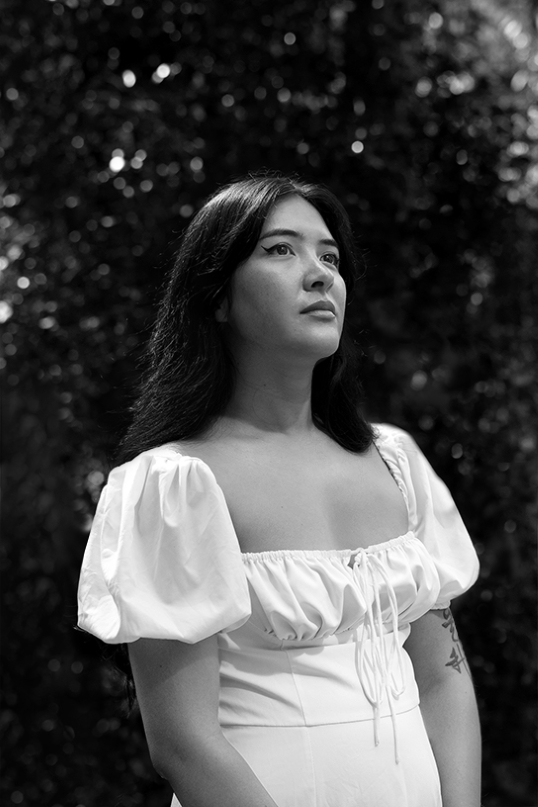Chléirigh-Ng’s multidisciplinary work, building on their background in set design, surpasses the borders of traditional theater and moves into the conceptual. The psychedelic neons and red ghostliness of WINDOW A WORLD situate Chléirigh-Ng’s vision of Hong Kong in the style of Hong Kong Second Wave cinema, evoking, in scholar and cultural critic Ackbar Abbas’s words, a discontinuous space of déjà disparu in relation to Hong Kong’s postcolonial “culture of [imminent] disappearance.” The visual richness of Chléirigh-Ng’s oeuvre posits Hong Kong’s continued appearance within the aesthetics of that déjà disparu.
To be displaced from a place is also to be displaced from language. Chléirigh-Ng’s practice creates a space that foregrounds these themes in new modes of performance across technical and substantive levels, equally displaced from theatrical tradition. Their theater becomes a home for displacement, a multisensual performance that reflects the multiple experiences and forms of leaving Hong Kong. What does it mean to speak Cantonese, or otherwise engage with Hongkongese culture, from afar? In what circumstances can language and culture survive despite disappearance?
I spoke with Choy-Ping Ní Chléirigh-Ng 吳彩萍 in July 2023.
—Michelle Chan Schmidt
As a theatermaker, do you prefer to call your work plays or pieces?
I call them pieces. A play is something quite specific that I don’t see my work fitting into. I wouldn’t say my pieces can be situated in theatrical repertoires in the way a play could be. I sometimes jokingly think to myself, What if you were to give this text to somebody else to perform? It’s not something that interests me at all.
All your pieces engage with Hong Kong from the outside in. WANDER WANDER WILD WILD 遊遊野野 and WINDOW A WORLD are both rooted in Hong Kong but take place in a liminal space elsewhere, real or imagined. When I first watched WINDOW A WORLD, I was struck by the intimate sensation of watching Hong Kong mutate from within that liminal space, through your evocations of local mythology, your layering of images, and your intricate play with languages. How did you begin creating WINDOW A WORLD?
The typical image you have of a theater is of curtains opening onto a stage, and the show beginning. Well, a window is like that, is it not?
The more I try to remember where this idea for a window came from, the more I think that it did come from Hong Kong. I grew up in a bungalow in Enniskerry, Co. Wicklow, and we didn’t have neighbors we could see through windows. When I lived in Hong Kong for the first time, I was in a flat in a three-story house in Tai Shui Hang, a village in the New Territories—not urban Hong Kong, but very dense, very close together. I remember that, during the evenings, I’d look out my window and see everything in the neighborhood: people cooking, playing with their kids, watching TV. It’s a strange feeling to witness that intimate life as a spectator. I think that’s part of the reason why I first thought about windows as an opportunity for performance.
I was offered the spot for WINDOW A WORLD in Dublin Theatre Festival on the condition that I would have to find a suitable location outside. Once I had the idea for the window, it took a lot of searching. The festival’s artistic director, Willie White, was the first one to suggest the café window we eventually used in Temple Bar, one of the city’s busiest areas. My first thought was to have a live performance in the window and project around it, but we couldn’t afford to access the café every evening. I was really panicking then, but I thought, I can project and I can use video. It’s obviously a different effect, but that’s what we ended up doing.
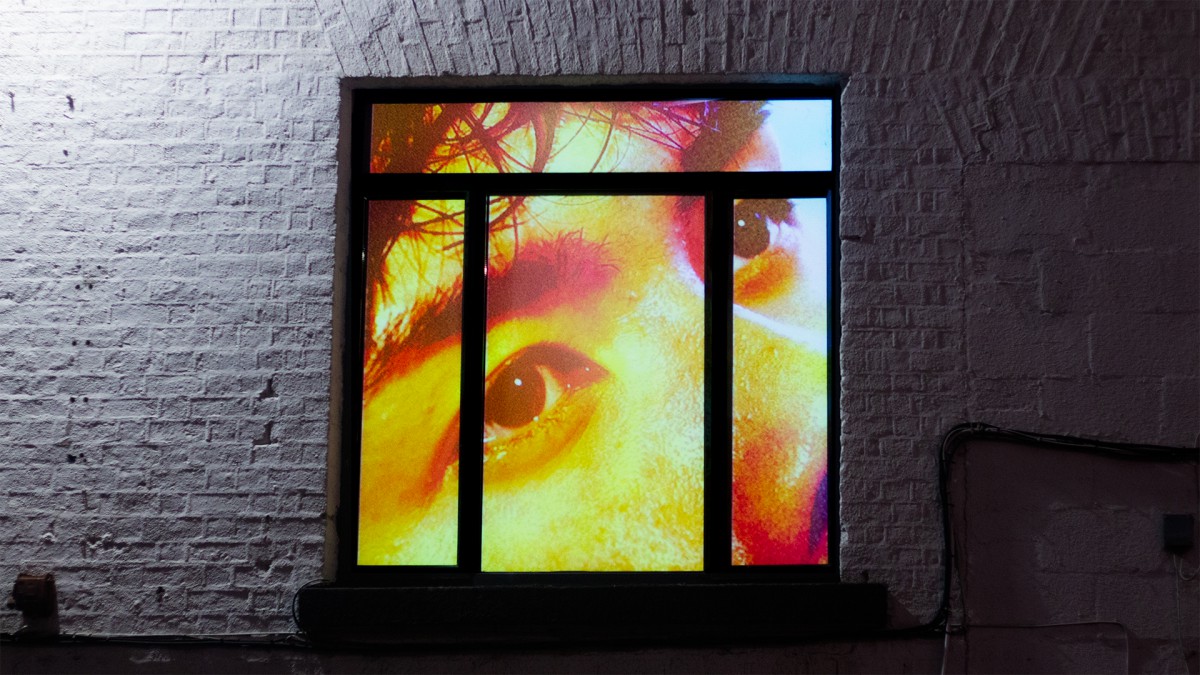
Photo by Isaac Harris, 2022
WINDOW A WORLD’s initial form was born mostly out of constraints, which is often the way things go in theater. You’re always trying to inventively solve problems related to the lack of resources and the capabilities of the venue. I couldn’t begin writing the script until I knew how we were going to present it.Despite the constraints, you were able to integrate a live performance into the piece. How did that mixed format come about?
At the time, it was the twenty-fifth anniversary of Hong Kong’s handover to China, exactly the midway point of the fifty-year agreement. I felt that I had to write something related to the transition of the Handover in some way.
Had I not met Hansun Lamb, the main performer, the piece would have been completely different. A lot of my work involves responding to what people can bring to the table—their skills and their zones of comfort—to give them a space to flourish in. To meet Hansun, with a similar Hongkongese-Irish experience, was very reassuring. I knew it had to end with Hansun appearing live, because he’s an amazing drag performer and lip-syncer. It was essential to me for the piece to contain live performance.
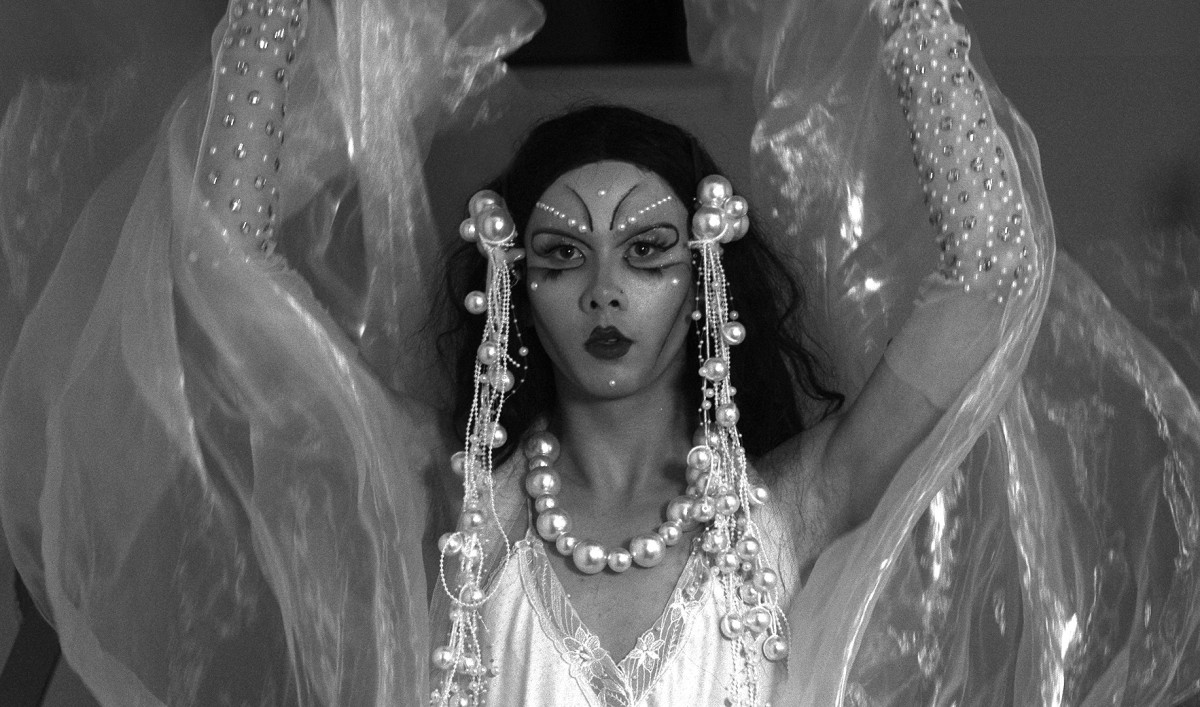
Photo by Isaac Harris, 2022
Both WANDER WANDER WILD WILD 遊遊野野 and WINDOW A WORLD code-switch or otherwise engage with multilingualism between English, Cantonese, and Hakka. How did Cantonese become an inspiration for you?I first began learning Cantonese in 2017, as an adult. As I become more confident in my understanding of the language, I’ve felt an increasing urge to include it in my work. Cantonese is used daily in Dublin, especially in certain areas, restaurants, supermarkets: it’s as day-to-day here as it is in many other places. That was my initial reason, beyond its cultural importance.
It’s equally important to represent the experience of characters in Hong Kong or in the Hongkongese diaspora: most of my family members in Hong Kong don’t speak English. They speak Cantonese and Hakka. It doesn’t make sense to imagine talking to my relatives in English. The current political issues around Cantonese in Hong Kong, with its erosion in favor of Mandarin, have also pushed me to work more with Cantonese.
Your introduction to WANDER WANDER WILD WILD 遊遊野野 is in Cantonese. You also play with language in WINDOW A WORLD by repudiating the audience’s right to understand, withholding subtitles until the second part of the production. You can infuse Cantonese with meaning or “reduce” it to sound in English-facing theater. How do you experiment with language as a technique?
Quite a few audience members were annoyed by the two-minute monologue without subtitles that opens WINDOW A WORLD, even though it ultimately resolves itself. I knew it was a risk to begin with a language that most of the audience wouldn’t understand, but do we always have to understand everything? I think people can get quite easily frustrated by language barriers and feel uncatered to. But the world doesn’t cater to everyone.
WANDER WANDER WILD WILD 遊遊野野 similarly obfuscates its discussion of the political situation in Hong Kong, skipping over any contextualization or explanation. Is that deliberate? How do you envision WANDER WANDER WILD WILD 遊遊野野 evolving?
How much can you say to give the audience enough information that they can put it together, either during the performance or after? If audiences are interested in learning about Hong Kong, other people write so much more eloquently and with more reliable information than I could ever share. I’m conscious of overexplaining or filling in too many gaps. I’m happy to leave some blanks for spectators to fill in their own time and with their own energy. I’m also aware of the danger of writing about political issues, and of course I’m wary of censorship. WANDER WANDER WILD WILD 遊遊野野’s first performance took place a year and half ago. I’m not sure that I’d stage such a politically explicit message now.
At the time, WANDER WANDER WILD WILD 遊遊野野 was the only piece in the Rough Ideas showcase without live actors. I was extremely embarrassed, but I couldn’t find most of the cast in Ireland due to the fact that the roles required Cantonese. I tried. I was emailing loads of people and asking if their relatives could come—I even envisioned a script reading instead of a complete performance. I ended up finding the cast online and we worked remotely to record their performances as audio only. Now I find that the actorless, video-centered form raises the question as to why I couldn’t find a cast. Why couldn’t I, in 2022, find people of Cantonese heritage to be onstage with me in Ireland? That fact is quite stark when you see it. People have to sit through the piece and think, Ping couldn’t find people to be in this.
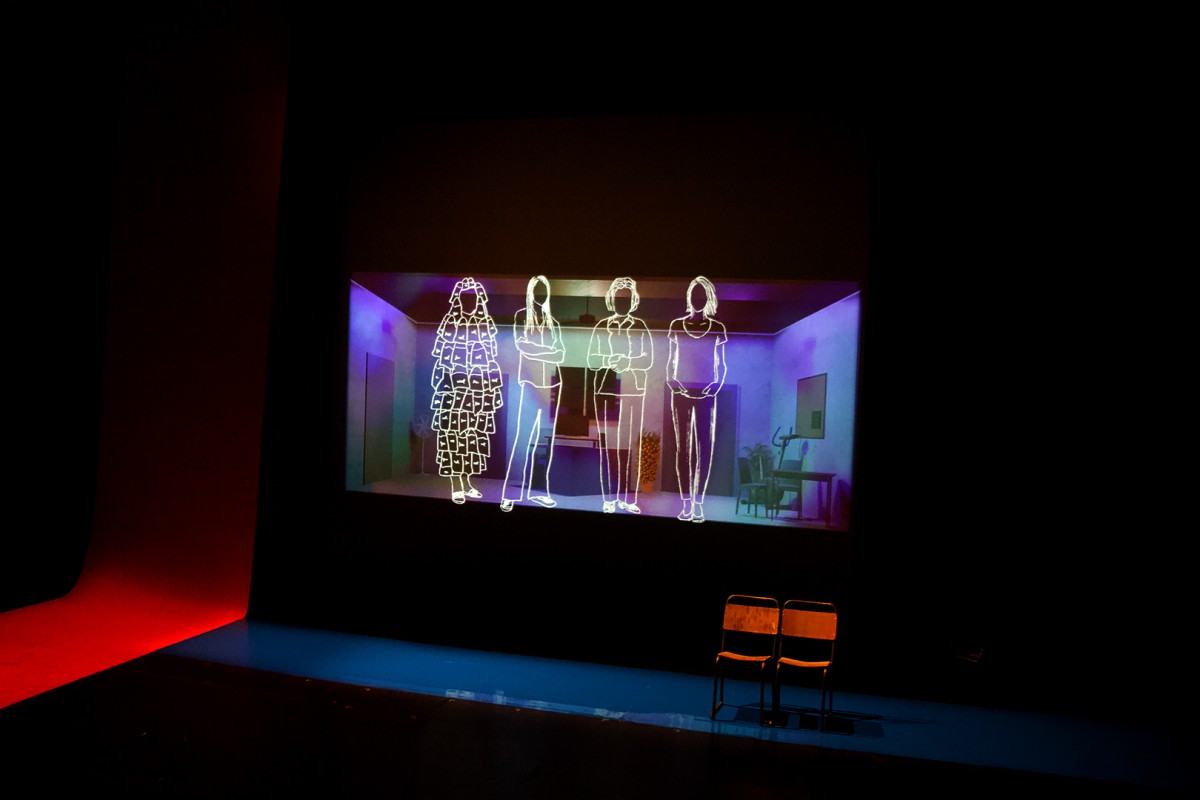
Photo by Jeda de Brí / Rough Magic, 2022
There’s this quotation from James Joyce: “Absence, the highest form of presence.” That performance of WANDER WANDER WILD WILD 遊遊野野 was a real moment where it surpassed what it meant to be an immigrant from Hong Kong and became about the current state of theater in Ireland and the fact that there are so few Asian people involved. I’m currently interviewing migrants to Ireland from Hong Kong, mostly recent arrivals—in the last five years or so—and letting my thoughts percolate for the final version that I’m working on.Can I ask you about absence as a stronger form of presence? You interpreted that to comment on the current state of theater in Ireland, but you could just as well extrapolate in the other direction, on Hong Kong as a space of disappearance and absence. It also ties in with the idea of drag and your integration of drag in WINDOW A WORLD: this state of in-between, this act of dissimulation, this space of transformation. How do you interpret those nuances in relation to Hongkongese culture, including to Cantonese?
When I was writing WINDOW A WORLD, I was thinking about being in-between. Hong Kong is obviously a place between past, present (a quite uncertain one), and future, undergoing huge change in ways we can’t tangibly know at this point. In terms of my own identity, I’ve always been in-between in many ways: it makes me quite interested in that in-between space. When we staged WINDOW A WORLD, the spectators who had bought tickets were live-streaming the audio on their own headphones. If you were a passerby, you would only see the visuals without hearing the audio aspect of it. We still had loads of people just standing and watching, especially the final performance, and applauding.
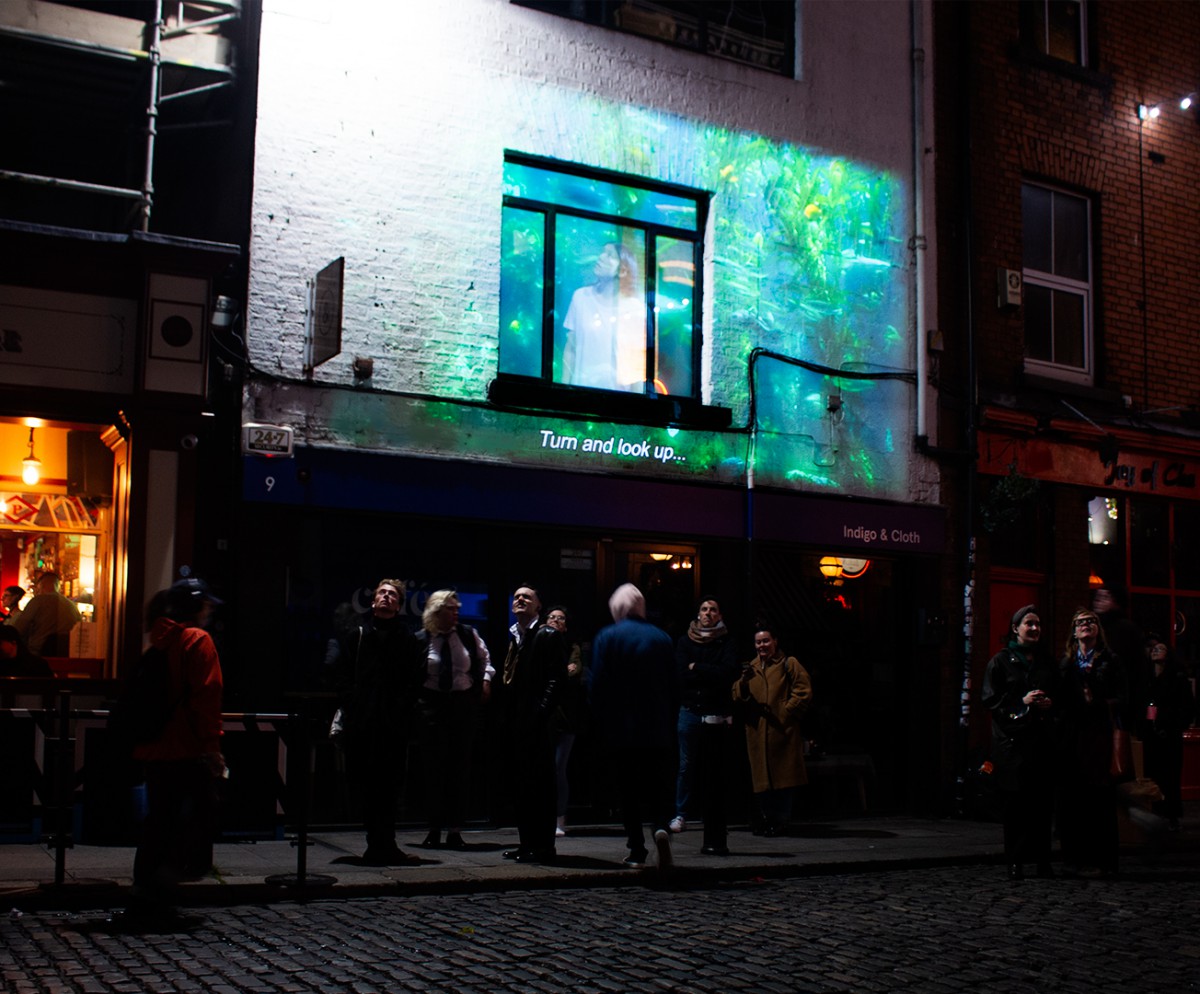
Photo by Isaac Harris, 2022
I was surprised that people could still enjoy it. I mean, Hansun looked great, and he was moving beautifully in the light, but I thought that it was quite strange. You had two audience experiences: about twenty people who’d paid and could hear everything, and the general public who seemed to still connect in some way without being able to hear. I was often watching without audio myself, and I felt like something was absent, something was missing in a lip-synced performance without any sound. Something had been lost in some way. In terms of absence being a higher form of presence, particularly in WANDER WANDER WILD WILD 遊遊野野, it wasn’t a link I was consciously making to Hong Kong, but there is definitely a metaphor there in relation to Hong Kong more directly disappearing.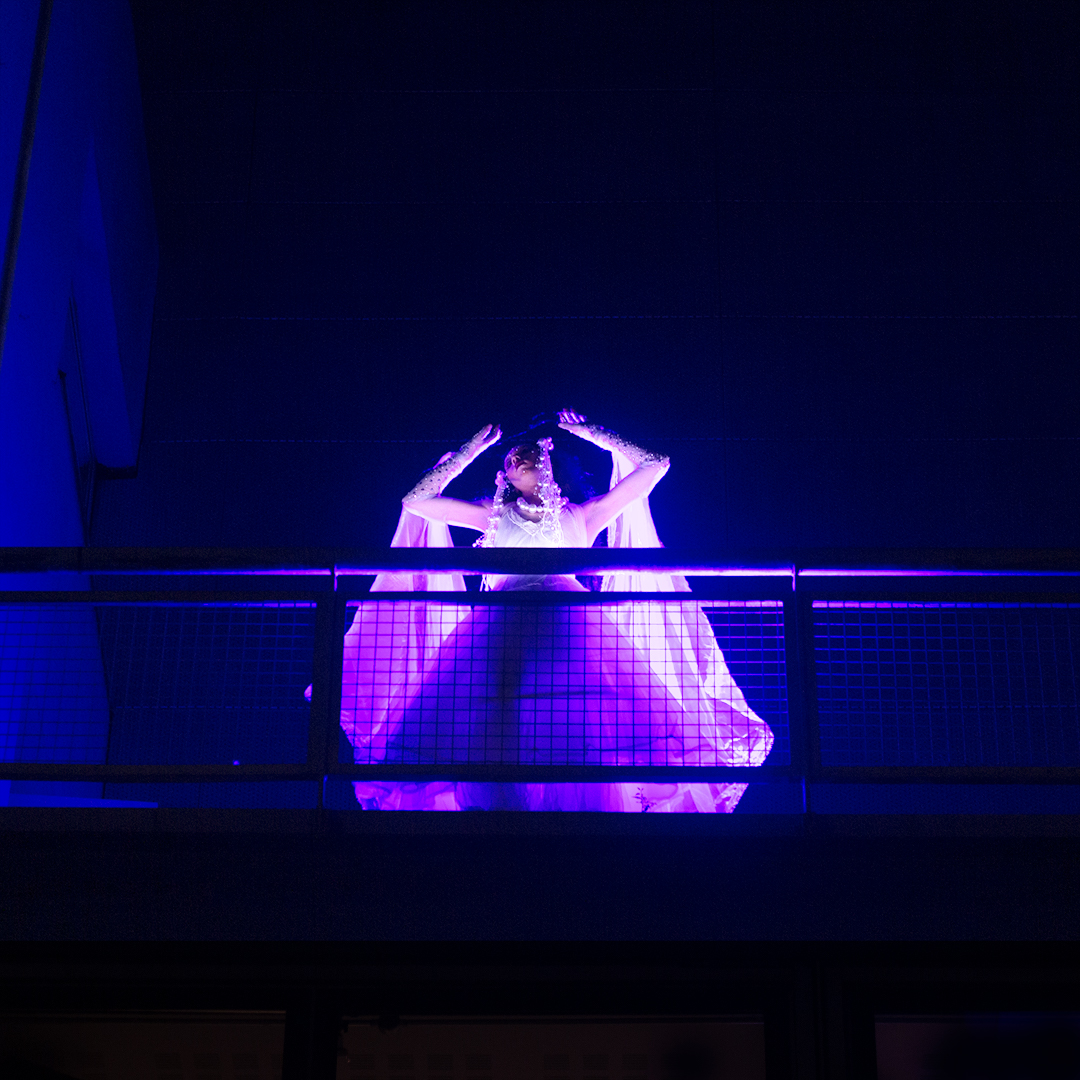
Photo by Isaac Harris, 2022
What about the title of WANDER WANDER WILD WILD 遊遊野野? Why did you choose to represent it with a Chinese name alongside the English?I read that there’s a Hakka idiom, “遊遊野野”, which means to wander around aimlessly. When I read that translation, I thought it matched the piece’s themes and intentions; the characters are wanderers in a new space of good and/or bad experiences. Some are lost, not knowing where they’re going.
The phrase’s syntax and sound translate well to English: its alliteration, its repetition, its mirroring of the Chinese four-character idiom. I can’t think of any equivalent idiomatic use in English. I thought that was an exciting reference that a Chinese-language speaker would instantly understand. I knew I wanted to use Hakka because that’s my dad’s first language. I knew I wanted one of the older relatives in the piece to speak Hakka, to honor that part of my heritage.
Your choice of a four-character expression as a Chinese name for your work riffs on Hong Kong culture, specifically the aesthetics of its cinema. The colors, ambience, quality, and atmosphere of Hong Kong cinema seem to translate fluently to your work, notably your video design for WINDOW A WORLD. How do you reflect your multilingualism and your own multidimensional identities in your work?
I do love the fragmented, abstract nature of classic 1980s Hong Kong cinema. I like when you can see texture, noise moving, or things pulsing and glowing. I began collaging the footage we shot for WINDOW A WORLD with textures and effects that I made digitally to give it a more dreamy look. The video work ended up as a collage of stuff that I thought had an ethereal, abstract quality to it.
I’ve been inspired by the idea of Gesamtkunstwerk: “total artwork.” In “total theater,” each element is equally important. Susanne Kennedy, whom I was lucky enough to be mentored by recently, is someone who I think considers all the elements really clearly.
How does that translate into your intentions for your work? Does audience reaction form a part of that Gesamtkunstwerk: do you want audiences to feel included or alienated by the overall effect of your work?
I think, in WINDOW A WORLD, I wanted the audience to feel transported to Hong Kong, to Tsuen Wan, through the visuals, the clips of the city streets, the sounds of the video. Immersion was important, because of the setting. As for WANDER WANDER WILD WILD 遊遊野野, I guess I wanted people to feel empathy or be moved even if the characters might be quite different from themselves.
WANDER WANDER WILD WILD 遊遊野野 incorporates some strands of postcolonial reckoning, from a Hongkongese as well as Irish perspective. How has studying literature shaped your theatermaking?
I really loved studying Irish literature in college, especially James Joyce: not only is he so experimental with language, but he writes about colonialism and being an exile. I often read his work to feel a bit more inventive. It’s pretty sad he couldn’t write like that in Ireland. So many people have to leave their home to do what they want to do, because their countries are not able to keep up with what’s innovative or boundary-pushing.
As for postcolonialism, a bit basic but classic: Edward Said. Orientalism blew my mind when I first read it. An orientalist view of the world persists and in some ways has gotten worse. It’s still so accepted to hold very racist views towards East Asian people and culture. I’m mixed-race and to some, quite white-passing, but I still feel the intensity of that orientalism. It’s something I’m always trying to fight against.
The Japanese playwright Satoko Ichihara said in an interview that the way the West views the East hasn’t changed much since the time Giacomo Puccini’s opera Madame Butterfly was written. I thought that was so true, which is grim. I admired her Madama Butterfly, which is a reimagining of Puccini’s opera through the perspective of the titular Japanese character.
Do you have any thoughts on how postcolonialism is viewed in Hong Kong, or how Hong Kong might view itself as a postcolonial space?
It’s something I’m really trying to understand. There seem to be stronger positive feelings towards the UK in Hong Kong than in Ireland, since the history is different. I find that quite jarring because I grew up questioning the British colonial project, but also because we now see the aftermath of British colonialism in Hong Kong and the lack of care the UK has had for Hong Kong post-1997. That positive mentality is something I’m trying to challenge in my work. But I also understand why it exists, because of the Handover and the current situation: it’s between a rock and a hard place.
I remember reading about the amount of violence that the British used to take Hong Kong and to keep it through the imperial period: they were killing many people to hold power. That violence is important to acknowledge and reckon with. It never was peaceful, and there was resistance: the guerrilla tactics that the locals used were apparently very innovative.
That narrative of Hong Kong is one that’s been less frequently told on a global scale. Theater could be a language to translate that history into, to fill in the gaps we feel within ourselves as we go from window to window.

